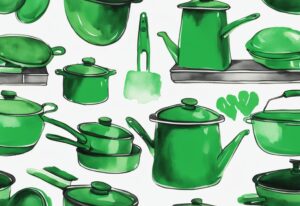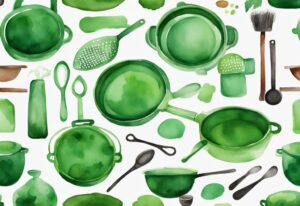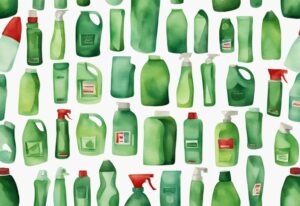Is GreenPan Non-Toxic? Truth about Safe Cookware
Are you concerned about the potential toxins lurking in your cookware? You’re not alone. As a fellow health-conscious individual, I too was drawn to GreenPan, a brand that promises non-toxic solutions for our kitchens. But does GreenPan truly live up to its claims of being free from PFAS, PFOA, lead, and cadmium?
In this article, we’ll delve deep into the heart of GreenPan’s unique Thermolon™ coating and its supposed benefits. We’ll scrutinize the materials, testing certifications, and real-world performance of GreenPan cookware.
Join me as we unravel the truth behind GreenPan’s non-toxic promises, empowering you to make an informed decision for a healthier, safer cooking experience.
Exploring GreenPan’s Non-Toxic Claims
GreenPan has made a name for itself by prioritizing non-toxic cookware, a commitment that resonates with many of us seeking healthier kitchen options. This section delves into the specifics of what makes GreenPan stand out in the realm of non-toxic cookware, focusing on its innovative materials and eco-friendly practices.
What Makes GreenPan Non-Toxic?
When I first asked myself, is GreenPan non-toxic, I was drawn to the brand’s dedication to eliminating harmful substances from its products. GreenPan’s cookware is crafted without PFAS, PFOA, lead, and cadmium—chemicals that are often lurking in conventional cookware and pose significant health risks. The brand’s avoidance of ‘forever chemicals’ like PFAS is particularly reassuring, given their notorious environmental persistence and potential health hazards.
One of the standout features of GreenPan is its Thermolon™ ceramic nonstick coating. Unlike traditional nonstick coatings, Thermolon™ doesn’t emit toxic fumes, even at high temperatures. This not only makes cooking safer but also contributes to a healthier kitchen environment. Plus, GreenPan’s manufacturing process is designed to be eco-friendly, producing 60% less CO2 compared to conventional nonstick production methods. This commitment to reducing carbon emissions aligns beautifully with the brand’s eco-conscious ethos, making it a compelling choice for environmentally aware cooks like us.
Thermolon™ Coating: A Safer Alternative?
The Thermolon™ coating is central to the discussion of whether is GreenPan non-toxic. This ceramic nonstick coating is made from inorganic ingredients, primarily silicon dioxide (SiO2), which comes from sand. By avoiding the plastic synthetics found in traditional nonstick coatings, Thermolon™ provides a safer alternative for those of us who are health-conscious. It can withstand high temperatures up to 450°C/850°F without releasing toxic fumes, offering reliability for various cooking techniques.

However, it’s important to acknowledge that some concerns linger about the full composition of the Thermolon™ coating. While marketed as a non-toxic solution, the lack of complete transparency about its ingredients has led to questions about potential undisclosed substances. This uncertainty highlights the need for ongoing research and independent testing to fully validate GreenPan’s non-toxic claims. As we increasingly prioritize safety and environmental impact, understanding the true nature of Thermolon™ becomes crucial in determining whether GreenPan truly offers a non-toxic cooking experience.
Ingredients and Materials Used in GreenPan Cookware
Exploring the materials and ingredients in GreenPan cookware reveals the brand’s dedication to non-toxic living. Each component is carefully selected to ensure safety and sustainability, setting GreenPan apart in the cookware industry.
Thermolon™: What’s in it?
When pondering is GreenPan non-toxic, Thermolon™ is the star of the show. This ceramic nonstick coating, crafted from silicon dioxide, resembles the simplicity of glass or sand. Through the Sol-Gel process, an inorganic polymer layer is formed, consciously excluding PTFE and PFOA—common culprits in traditional nonstick coatings. While Thermolon™ earns praise for its non-toxic credentials, whispers of potential toxins like silane and aluminum oxide occasionally surface. These concerns, however, remain unproven, inviting further scrutiny and transparency to reassure us of its safety.
Does GreenPan Use Harmful Chemicals?
The journey to understanding is GreenPan non-toxic involves delving into the brand’s steadfast commitment to avoiding harmful chemicals. GreenPan proudly markets its cookware as free from PFAS, PFOA, lead, and cadmium, setting it apart from conventional nonstick pans that often rely on plastic synthetics. This absence of harmful substances is a beacon for health-conscious individuals like us. Yet, a hint of skepticism lingers due to the absence of exhaustive third-party testing that could conclusively affirm the absence of all potential toxins. As we increasingly seek transparency, GreenPan faces the challenge of offering more detailed testing results to bolster its non-toxic claims.
GreenPan’s Testing and Certification
GreenPan is renowned for its dedication to non-toxic cookware, and this commitment is evident through their rigorous testing and certifications. Let’s explore how they ensure their products are safe and reliable.
What Third-Party Certifications Does GreenPan Have?
GreenPan’s journey towards creating non-toxic cookware is a testament to their dedication to safety and quality. Their Thermolon™ coating, a hallmark of GreenPan products, has undergone extensive evaluation by several esteemed international standards organizations. These include the USA FDA, German LFGB, Swiss government, and KTR. Such certifications are not just badges of honor; they are assurances that GreenPan cookware is free from harmful substances. If you’re interested in learning more about how to use GreenPan products, you might also want to explore how to use a green mask stick effectively to enhance your cooking experience. The detailed test reports reveal no detectable levels of lead or cadmium, and the aluminum levels are comfortably within safety limits. This comprehensive testing process is a reflection of GreenPan’s unwavering commitment to offering non-toxic cookware for those of us who prioritize health in our kitchens.

How Does GreenPan Ensure Quality and Safety?
At GreenPan, quality and safety are not just goals; they are integral to the entire production process. By owning their manufacturing facilities, GreenPan ensures that every step, from material selection to production, meets their stringent standards. Their in-house testing laboratory is a cornerstone of their quality assurance, continuously monitoring product safety. However, it’s worth noting that GreenPan has faced some criticism for not releasing updated test reports since 2020. This gap in transparency has sparked a bit of skepticism about the current state of potential toxicity. Despite this, GreenPan’s infrastructure and processes are designed to maintain their reputation as a leader in non-toxic cookware, meeting the growing demand for safer kitchen products.
Consumer Experiences with GreenPan Cookware
GreenPan cookware has become a staple in many kitchens, celebrated for its promise of non-toxic cooking. This section delves into how GreenPan performs over time and addresses common concerns about its non-toxicity.
How Does GreenPan Perform Over Time?
Over the years, I’ve found that GreenPan cookware can truly stand the test of time, provided it’s treated with a bit of care. It’s like nurturing a relationship; you get back what you put in. The key to preserving its non-toxic magic lies in avoiding high heat and choosing the right utensils. I’ve learned this the hard way, as some of my pans showed wear when I wasn’t as careful. When the non-stick coating starts to fade, there’s a risk of exposing the aluminum base, which is a gentle reminder of the importance of proper care.
Regular maintenance, like a quick hand wash and avoiding metal utensils, can work wonders. It’s all about keeping the integrity of that coating intact. If you’re exploring safer alternatives, consider checking out non toxic dinnerware brands to ensure your kitchenware is safe and durable. This way, your GreenPan continues to offer a safe and non-toxic cooking experience. Trust me, the effort is worth it for the peace of mind it brings.
Common Concerns About GreenPan’s Non-Toxicity
I’ve come across many discussions about GreenPan’s non-toxic claims, and it’s understandable why some might feel skeptical. Transparency is crucial, and the lack of detailed testing information can leave us wondering. There was a notable lawsuit back in 2019 that questioned their marketing, and although it was dismissed, it left a few lingering doubts.
These concerns highlight the need for brands to be open and honest. When it comes to non-toxic living, trust is everything. We all want to be sure that what we’re using in our homes is truly safe. This is why comprehensive testing and clear communication are so important. It’s about building confidence and ensuring that our choices align with our values for health and sustainability.

Conclusion: Is GreenPan Truly Non-Toxic?
GreenPan cookware is designed with a clear mission: to be non-toxic and free from harmful chemicals. This makes it a safer option for those of us who love to cook and care about what we’re using in our kitchens. The brand’s commitment to sustainability and health aligns beautifully with the increasing demand for eco-friendly kitchen products. By eliminating harmful substances like PFAS, PFOA, lead, and cadmium, GreenPan strives to offer a healthier cooking experience.
But let’s dive deeper—can we truly say GreenPan is non-toxic in every aspect? There’s a bit of a gray area here. The lack of transparency and comprehensive independent testing has led to some skepticism about the brand’s non-toxicity claims. While GreenPan has received certifications from reputable organizations, the absence of recent test reports can be a bit unsettling for those of us who want to be absolutely sure about the safety of our cookware.
I always encourage my readers to actively seek out test reports and certifications to verify these claims. It’s also crucial to remember that proper care and maintenance of your cookware play a significant role in preserving its non-toxic properties. By avoiding high heat and using suitable utensils, you can extend the lifespan of the non-stick coating and minimize potential exposure to the aluminum base.
In summary, while GreenPan positions itself as a non-toxic choice, there’s still a need for greater transparency and independent verification. As we continue to prioritize health and sustainability, making informed decisions based on available evidence and proper product care is essential. Let’s keep striving for a healthier lifestyle, one informed choice at a time.
FAQ
Is GreenPan Completely Free of Toxins?
I’ve often found myself wondering about the safety of the cookware I use daily. GreenPan claims their products are free from PFAS, PFOA, lead, and cadmium, which is reassuring. However, the absence of extensive testing for other potential toxins does leave a lingering question mark, especially considering that nonstick cookware can contain harmful substances like PFAS, which are often referred to as ‘forever chemicals’ due to their persistence in the environment. For more information on the health risks associated with nonstick pans, you can read about it here: are nonstick pans safe or toxic. It’s a bit like walking a tightrope, balancing between trust and caution. While I appreciate their efforts, I encourage you to stay informed and make choices that align with your comfort level regarding non-toxicity.
How Does Thermolon™ Compare to Traditional Nonstick Coatings?
In my journey towards a non-toxic kitchen, discovering Thermolon™ was a game-changer. This ceramic-based coating is a breath of fresh air compared to traditional nonstick options. Unlike those that might release toxic fumes when overheated, Thermolon™ avoids PTFE and plastic synthetics entirely. It’s like choosing a gentle breeze over a smoky haze. This shift not only benefits our health but also contributes to a more sustainable planet, a win-win in my book!
What Should I Do if GreenPan’s Non-Stick Coating Deteriorates?
I’ve learned the hard way that when a non-stick coating starts to deteriorate, it’s time to part ways with that pan. Continuing to use it could expose you to the aluminum base, which is something we all want to avoid. To extend the life of your GreenPan, consider using wooden or silicone utensils and keeping the heat at a moderate level. These small adjustments can make a big difference, helping you maintain a safe and healthy kitchen environment.
Hi, I’m Olivia Green, the voice behind nontoxicways.com. I’m passionate about helping you make the shift to a healthier, non-toxic lifestyle without feeling overwhelmed. I love sharing my personal journey, from small changes to big transformations, along with practical tips that make it all feel doable. My goal is to inspire and guide you toward a lifestyle that benefits both your well-being and the planet. Let’s take this journey together, one simple step at a time!














Post Comment